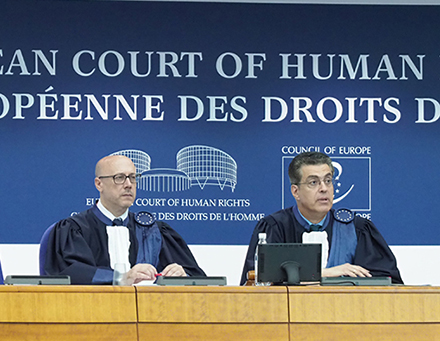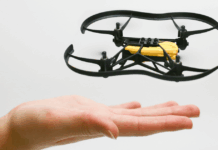
The case Abu Zubaydah v. Lithuania (application no. 46454/11) concerned the applicant’s allegations that Lithuania had let the United States Central Intelligence Agency (CIA) transport him onto its territory under the secret extraordinary rendition programme and had allowed him to be subjected to ill-treatment and arbitrary detention in a CIA detention “black site”. He also complained that Lithuania had failed to carry out an effective investigation into his allegations.
The applicant was Zayn Al-Abidin Muhammad Husayn, who is also known as Abu Zubaydah.
In today’s Chamber judgment in the case the European Court of Human Rights held, unanimously, that there had been:
violations of Article 3 (prohibition of torture) of the European Convention on Human Rights, because of the Government’s failure to effectively investigate Mr Husayn’s allegations and because of its complicity in the CIA’s actions that had led to ill-treatment; and violations of Article 5 (right to liberty and security), Article 8 (right to respect for private life), and Article 13 (right to an effective remedy), in conjunction with Article 3.
The Court had no access to Mr Husayn as he is still being held by the US authorities in very restrictive conditions so it had to establish the facts from various other sources. In particular, it gained key information from a US Senate Committee report on CIA torture which was released in December 2014. It also heard expert witness testimony.
The Court concluded that Lithuania had hosted a secret CIA prison between February 2005 and March 2006, that Mr Husayn had been detained there, and that the domestic authorities had known the CIA would subject him to treatment contrary to the Convention. Lithuania had also permitted him to be moved to another CIA detention site in Afghanistan, exposing him to further ill-treatment.
The Court found that Mr Husayn had been within Lithuania’s jurisdiction and that the country had been responsible for the violations of his rights under the Convention.
It recommended that Lithuania conclude a full investigation of what Mr Husayn’s case as quickly as possible and, if necessary, punish any officials responsible. The country also had to make further representations to the United States to remove or limit the effects of the violations of his rights.
The Court has today also found in the case Al Nashiri v. Romania that Romania violated the rights of another CIA prisoner, Abd Al Rahim Husseyn Muhammad Al Nashiri, in similar circumstances.
Principal facts
Mr Husayn is a stateless Palestinian who was born in 1971 and is being held in the Internment Facility at the United States (US) Guantánamo Bay Naval Base.
1. Under Articles 43 and 44 of the Convention, this Chamber judgment is not final. During the three-month period following its delivery, any party may request that the case be referred to the Grand Chamber of the Court. If such a request is made, a panel of five judges considers whether the case deserves further examination. In that event, the Grand Chamber will hear the case and deliver a final judgment. If the referral request is refused, the Chamber judgment will become final on that day.
Once a judgment becomes final, it is transmitted to the Committee of Ministers of the Council of Europe for supervision of its execution.
Further information about the execution process can be found here: www.coe.int/t/dghl/monitoring/execution.
He was initially considered by the US authorities as the “third or fourth man” in al-Qaeda and was seized in Faisalabad, Pakistan, in March 2002. He was suspected of being a planner of the 11 September 2001 attacks and a senior lieutenant to Osama bin Laden. He was the first so-called “high-value detainee” (“HVD”) detained by the CIA at the start of the “war on terror” launched by President Bush. He has never been charged with any offence.
The European Court established in Mr Husayn’s first case (Husayn (Abu Zubaydah) v. Poland) that after his capture he had been held in a CIA detention facility in Thailand before being moved to another “black site” in Poland in December 2002. He was detained there until September 2003.
The applicant submitted in this case that he had been secretly transferred from Poland to the prison at Guantánamo and then to Morocco in 2004. He had later been moved to Lithuania on 17 or 18 February 2005 and transferred out of that country to Afghanistan on 25 March 2006.
According to the applicant, he was subjected to torture and other forms of ill-treatment prohibited by Article 3 of the Convention throughout his detention by the CIA.
Mr Husayn described his treatment in testimony in 2006 to the International Committee of the Red Cross (ICRC) and in partly declassified transcripts of evidence to the US military Combatant status Review Tribunal in 2007.
It included interrogators putting a black cloth over his face and pouring water over it so he could not breathe; slamming him into a wall and slapping his face; playing loud music while he was kept in a tall box; depriving him of food; and keeping him naked in cold conditions. He told the Tribunal that doctors had told him that he had nearly died four times during months of interrogation. He also alleged that he had been kept in continuous solitary confinement and incommunicado detention throughout his undisclosed detention. He had no knowledge of where he was being held and no contact with persons other than his interrogators or guards.
He stated that he suffers from blinding headaches and an acute sensitivity to sound. He had more than 300 seizures between 2008 and 2011 and at some point during his captivity he lost an eye International media reported in 2009 that Lithuania was among the eastern European countries which had hosted a secret CIA prison, at a former riding school near capital city Vilnius.
A subsequent Lithuanian Parliament committee inquiry found that CIA planes had landed in Lithuania in 2004, 2005 and 2006 and that the CIA and the domestic intelligence services had reconstructed two facilities together. However, Parliament could not determine whether any detainees had been flown in on the CIA planes or held at the bigger of the two facilities.
Finally, the inquiry found that senior Lithuanian officials had only known in general terms of cooperation with the CIA. A 2010 investigation by the Prosecutor General’s Office into abuse of office by officials in connection with the alleged CIA operations ended in 2011 without any prosecutions. The investigation was reopened in 2015 and is still ongoing.
Complaints, procedure and composition of the Court Mr Husayn complained that Lithuania had enabled the CIA to detain him secretly on its territory and subject him to torture, various other forms of mental and physical abuse and incommunicado detention, thus denying him the possibility to contact his family or the outside world.
He also complained that Lithuania had allowed him to be transported to another foreign secret detention site, exposing him to years of further similar treatment. Lastly, he complained of the lack
of a prompt and thorough investigation into his allegations. Mr Husayn relied on Article 2 (right to life), Article 3 (prohibition of torture), Article 5 (right to liberty and security), Article 6 (right to a fair trial within a reasonable time), Article 8 (right to respect for private and family life), Article 13 (right to an effective remedy) and Article 1 of Protocol No. 6 (abolition of the death penalty).
The application was lodged with the European Court of Human Rights on 14 July 2011.
The Helsinki Foundation for Human Rights, Amnesty International and the International Commission of Jurists submitted comments as third parties. A fact-finding hearing was held on 28 June 2016 and a public hearing on 29 June 2016.
Judgment was given by a Chamber of seven judges, composed as follows:
Linos-Alexandre Sicilianos (Greece), President,
Kristina Pardalos (San Marino),
Robert Spano (Iceland),
Aleš Pejchal (the Czech Republic),
Egidijus Kūris (Lithuania),
Mirjana Lazarova Trajkovska (“the former Yugoslav Republic of Macedonia”),
Paul Mahoney (the United Kingdom),
and also Abel Campos, Section Registrar.
Decision of the Court
The Court first dealt with objections by the Government’s that Mr Husayn’s allegations were a restatement of inquiry reports and media articles. There was no proof the CIA had taken him to Lithuania and detained and ill-treated him there with the knowledge of the domestic authorities.
The Court observed that the case was largely based on circumstantial evidence, noting that only Mr Husayn’s US legal representative, with top-secret security clearance, was allowed to see him. The evidence included, in particular, the 2014 declassified executive summary of the US Senate report on CIA torture, which detailed the activities of the CIA in the HVD programme in the years 2001-2009. The Court also reviewed Mr Husayn’s testimony in the ICRC report and his statements to the Combatant Status Review Tribunal.
In addition, it took account of international inquiries, such as the three reports by Council of Europe Parliamentary Assembly rapporteur Dick Marty from Switzerland and redacted documents released by the CIA. It heard the testimony of Senator Marty and two experts on the CIA rendition programme, Mr J.G.S., a lawyer and investigator who has worked with Senator Marty, and Mr Crofton Black, an investigator with the Bureau of Investigative Journalism and British NGO Reprieve, a British non-governmental organisation representing the interests of some of the detainees held in Guantánamo.
The evidence included details of how detainees had been ill-treated, the movement of aeroplanes known to have been used by the CIA for rendition operations, how the CIA had paid foreign governments to host sites and how the programme had developed over the years.
In particular, the 2014 US Senate Committee report on CIA torture provided information about the transfer dates and times, and the interrogation schedules of CIA detainees. It also spoke clearly of cooperation with the domestic authorities and of them being provided with millions of dollars to show appreciation for their “support” for the CIA extraordinary rendition programme. The actual amount and the concrete recipients were redacted out of the report.
A careful reading of the report allowed the Court to conclude that the detention centre known as Site Violet, one of the places where Mr Husayn had been held, was located in Lithuania.
Based on all the material, the Court concluded that it was clear that Lithuania had hosted a CIA detention centre from 17 or 18 February 2005 to 25 March 2006 and that Mr Husayn had been held
there.
The Lithuanian authorities had known of the purpose of the CIA’s activities on its territory and had cooperated. It must also have been clear that such actions had threatened Mr Husayn’s rights. Overall, his allegations fell within Lithuania’s jurisdiction and could make it answerable under the Convention.
Article 3
The Court found a violation of the procedural aspect of Article 3 as Lithuania had failed to carry out a proper investigation related to Mr Husayn. The investigation had tailed off from June 2010 and prosecutors had ignored Reprieve’s suggestions to trace US citizens who had been on board one of the aeroplanes which had landed in Lithuania and whose passport details they had possessed.
The reopened investigation, which included a request for legal assistance to the United States, had also made no meaningful progress.
On the substantive aspect of Article 3, the Court noted that Mr Husayn’s statements to the Tribunal in March 2007 and in the 2007 ICRC report provided a shocking account of the cruel treatment he had suffered in CIA custody. He had not been subjected to such severe ill-treatment in Lithuania, but his prior suffering had to be taken into account when considering his detention there.
In any event, in Lithuania he had also experienced an extremely harsh detention regime, which, according to CIA documents, had as standard practice included blindfolding or hooding, solitary confinement, the continuous use of leg shackles, and exposure to noise and light.
Such suffering amounted to inhuman treatment within the meaning of the Convention, which Lithuania had enabled by cooperating with the CIA. Moreover, it had allowed his rendition out of the country and exposed him to a foreseeable serious risk of further ill-treatment.
Article 5
Lithuania had enabled the CIA to transport Mr Husayn in and out of the country and hold him in secret. Unacknowledged detention was a complete negation of the guarantees of the Convention and a serious violation of Article 5.
Article 8
The interference with Mr Husayn’s rights had taken place in the context of fundamentally unlawful and undisclosed detention. There had been no justification for it under Article 8 and his rights under this provision had therefore been breached.
Article 13
The Court observed that it had already found that the investigation into Mr Husayn’s allegations had fallen short of Convention standards. He had also had no effective remedy available to complain about violations of his rights. There had been a breach of Article 13, in conjunction with Article 3.
Article 46
The Court noted that Lithuania had asked for some legal assistance from US officials during the reopened investigation. However, it recommended that the country make further representations to the United States to remove, or at the very least, seek to limit the effects of the violations of the applicant’s rights.
In addition, the reopened domestic investigation should be concluded as swiftly as possible once the circumstances of Mr Husayn’s transport, detention and removal from Lithuania had, as far as possible, been clarified. The investigation should also aim to allow the domestic authorities to identify and, where appropriate, punish those responsible. Just satisfaction (Article 41)
The Court held that Lithuania was to pay the applicant 100,000 euros (EUR) in respect of nonpecuniary damage, and EUR 30,000 in respect of costs and expenses.













